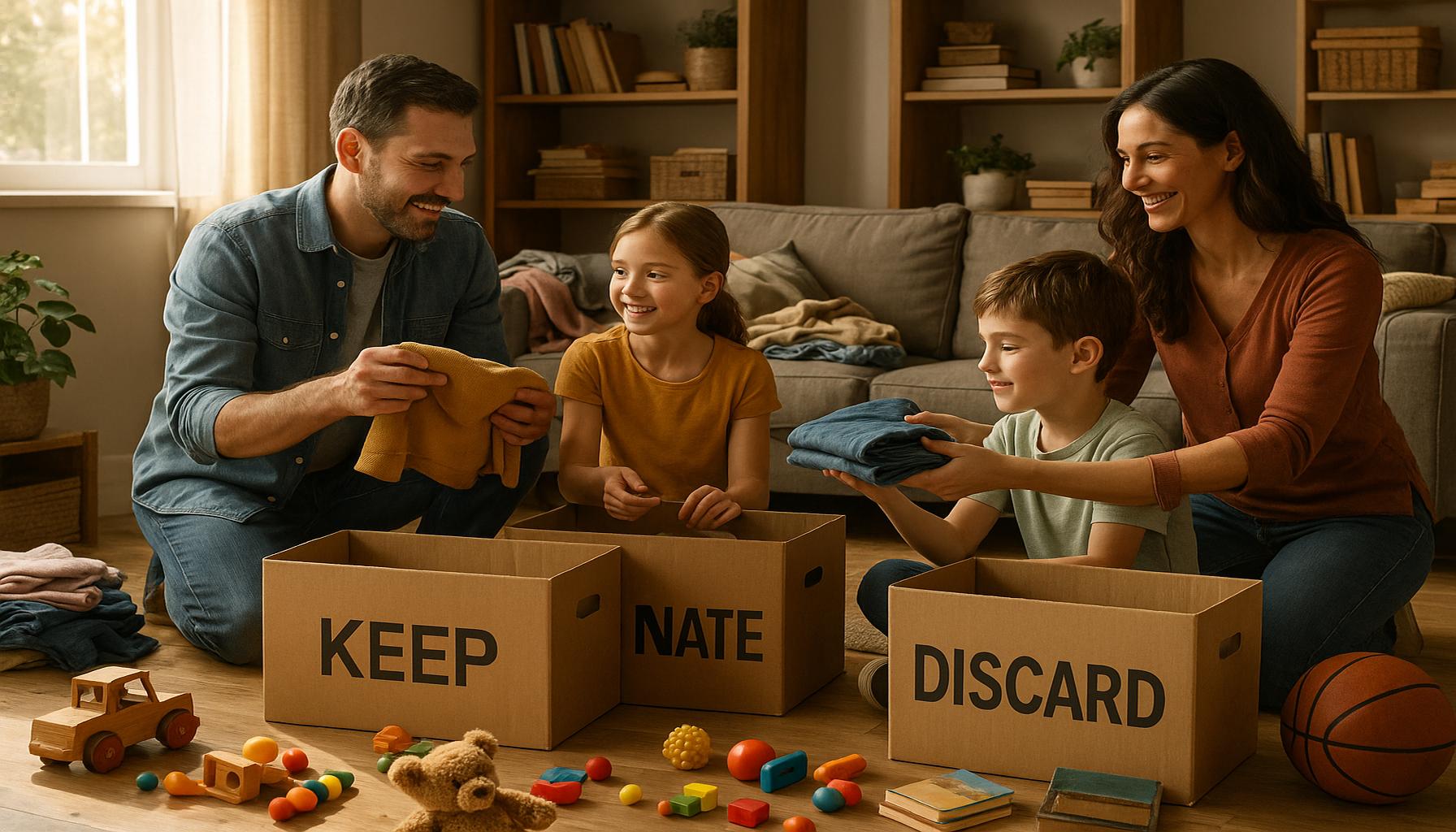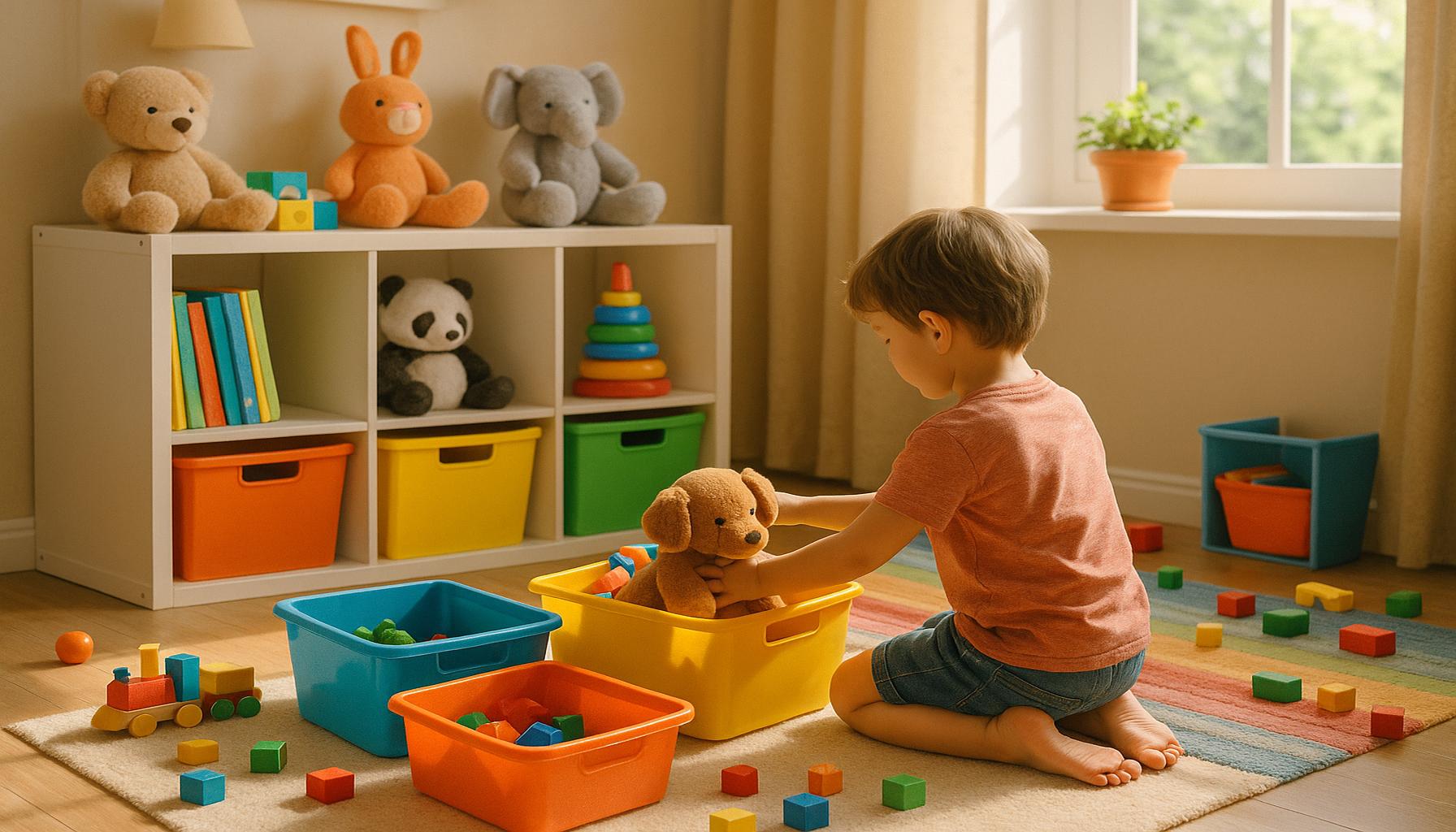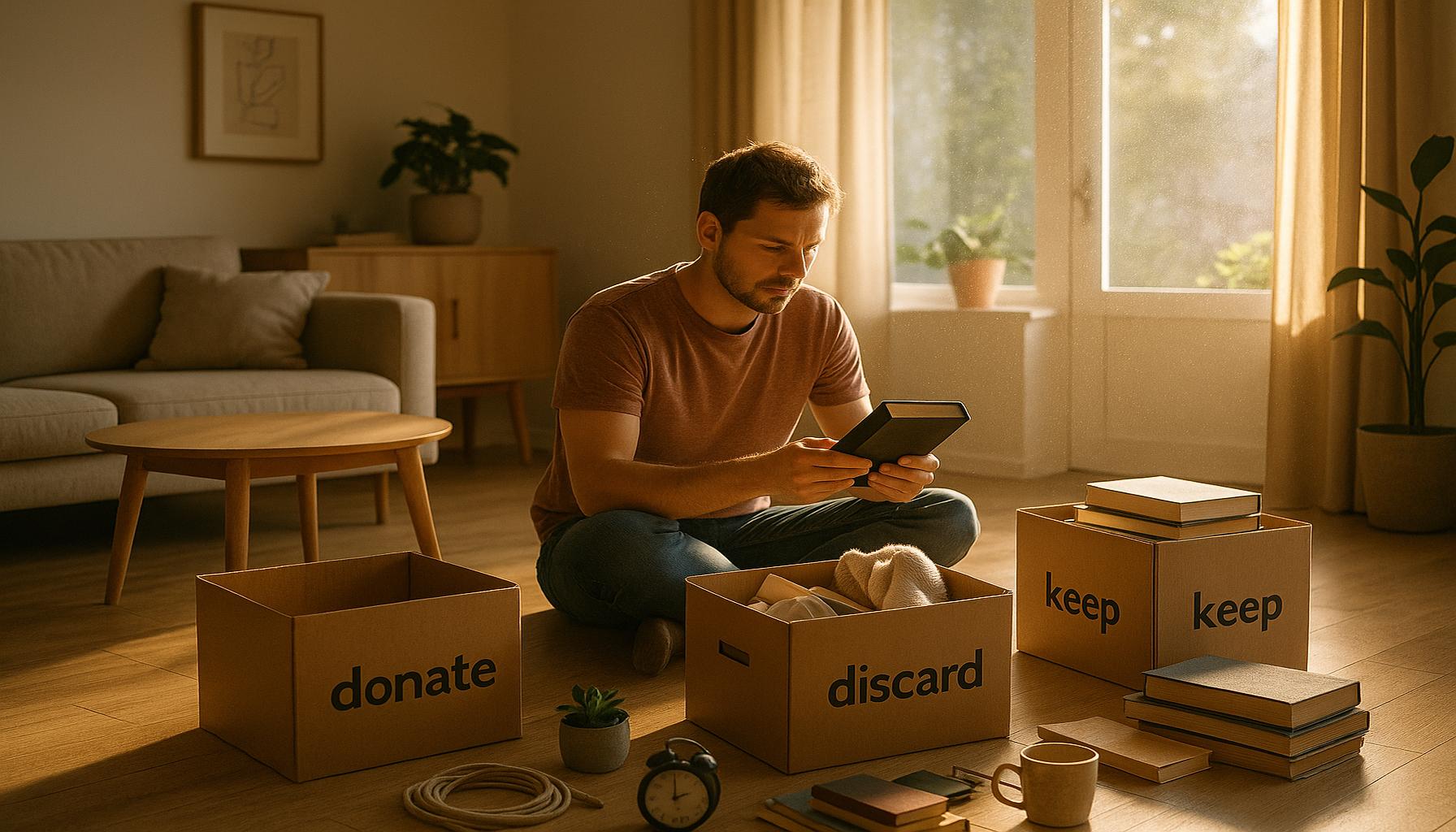Decluttering in the Family: How to Involve Everyone in Reducing Household Clutter

Understanding the Need to Declutter
Clutter is a common concern for many households, with items accumulating over time, often leading to a chaotic living environment. This buildup can create a sense of stress and overwhelm, making the prospect of decluttering feel daunting. However, transforming decluttering into a collaborative effort can change this perception. Instead of viewing it as a chore, involving family members in the process can turn it into an enjoyable activity that strengthens relationships and promotes a shared sense of ownership for the home.
Benefits of Family Participation
Decluttering as a family brings several benefits that extend beyond just a tidy space. Embracing teamwork and communication during this process can enhance familial bonds. Here are some of the key advantages:
- Shared Responsibility: When everyone pitches in, the workload becomes lighter for all involved. A collective effort distributes tasks, reducing stress and making the process more manageable. For instance, one family member can focus on toys while another tackles books, ensuring that no single person feels overwhelmed.
- Teaching Life Skills: Involving children in decluttering can impart essential skills such as organization, decision-making, and responsibility. By engaging them in determining what to keep or donate, children learn valuable lessons about material possessions and the importance of giving back to the community.
- Creating Memories: The act of sorting through items can evoke nostalgia, leading to storytelling and laughter. Whether it’s reminiscing about a family trip captured in old photographs or laughing about the quirky toys of yesteryear, these moments can strengthen family ties and create lasting memories.
Steps to Involve Everyone
An effective decluttering project begins with a thoughtful approach that includes everyone in the family. Here are some practical steps to streamline the process:
- Family Meetings: Begin with a family discussion about the impact of clutter on daily life and establish collective goals. This ensures that everyone understands the purpose behind the efforts and is motivated to participate.
- Set a Timeline: Create a decluttering timeline that accommodates all family members’ schedules. Designate specific days or weekends for tackling different areas of the home, promoting accountability and commitment.
- Designate Areas: Assign specific rooms or zones to each family member. This targeted approach allows individuals to focus their efforts on their assigned space, making the task feel less overwhelming and more organized.
Inspiring Success
When families work together to declutter, the results extend far beyond a neat home. Each item donated or discarded can lead to a profound sense of achievement and satisfaction. This sense of accomplishment can inspire ongoing habits of organization among family members. Moreover, when decluttering becomes a regular family activity, it helps cultivate a lifestyle centered around minimalism and mindfulness about possessions. Families may find themselves embracing fewer items, leading to a more harmonious living space where each member feels at ease.
Ultimately, the journey of decluttering can lead to not only a more organized home but also a more connected family dynamic, fostering a sense of teamwork, respect, and understanding within the household.
DISCOVER MORE: Click here to enhance your productivity
Steps to Involve Everyone
A successful decluttering project requires a plan that includes every family member, minimizing resistance and maximizing participation. By creating a structured approach, families can tackle clutter in a way that feels less daunting and more rewarding. Below are some practical steps to ensure that every person’s voice and effort are valued:
- Family Meetings: Start with an open discussion that emphasizes the emotional and physical impacts of clutter on daily life. Use this time to discuss shared experiences, from losing items to feeling overwhelmed by the state of the home. Setting collective goals can boost motivation and ensure that every voice is heard, reinforcing the importance of teamwork. For example, discussing what aspects of the home feel chaotic can lead to actionable goals like making a specific room clutter-free.
- Set a Timeline: Establishing a decluttering timeline tailored to your family’s schedule is essential for maintaining momentum. Designate specific days for decluttering smaller sections of the house instead of attempting to conquer everything at once. You might carve out a weekend for the garage or an afternoon for children’s rooms. Ensuring each family member is aware of and agrees on timeframes promotes accountability.
- Designate Areas: Assigning specific rooms or zones to each family member can streamline the decluttering process. This method transforms the task into manageable segments, allowing individuals to exert control over their assigned spaces. For instance, parents might tackle the kitchen while children focus on their play areas or bedrooms. This division of responsibility also encourages ownership over personal spaces and promotes pride in one’s environment.
- Use the Four-Box Method: Introduce a fun and structured way to declutter by utilizing the four-box method: Keep, Donate, Trash, and Unsure. Each family member can sort items into four distinct boxes, making critical decisions about what to retain and what can go. This method not only simplifies the process but also encourages critical thinking about material possessions and helps to clarify what is genuinely needed.
- Make it a Family Event: To boost enthusiasm, transform decluttering sessions into family events. Consider introducing music, timers for quick sorting challenges, or even a friendly competition to see who can declutter the most in a set timeframe. Celebrating small victories and supporting one another can enhance the overall experience and keep spirits high throughout the process.
At its core, decluttering should not feel like a punishment; rather, it should be an opportunity for family bonding and growth. By actively engaging everyone, families can foster a participatory spirit that can permeate various aspects of household management, leading to sustainable habits around organization and mindful living.
| Category | Description |
|---|---|
| Family Collaboration | Involving every family member in the decluttering process fosters teamwork. |
| Shared Responsibility | Each member feels a sense of ownership in maintaining a clutter-free home. |
| Emotional Benefits | Decluttering together strengthens family bonds and reduces stress. |
| Life Skills | Teaching kids organization and decision-making skills for future independence. |
Involving the entire family in the decluttering process can render significant advantages that go beyond simple tidiness. Engaging in this collective activity can cultivate a spirit of collaboration as each family member contributes to creating a harmonious living space. This approach also fosters a sense of shared responsibility, which can help instill important values in children, such as the importance of maintaining a clean environment and the benefits of mindful consumption.Moreover, decluttering as a family can evoke emotional benefits, creating moments that forge stronger relationships. As members work side by side, they experience shared triumphs and collective goals, ultimately leading to a positive family atmosphere. Additionally, by teaching children valuable life skills through this process, parents can equip them with essentials that they will carry into adulthood, helping them make informed lifestyle choices that promote simplicity and mindfulness. Delving deeper into this transformative journey offers families an opportunity not only to revitalize their space but also to enrich their connections.
DIVE DEEPER: Click here to discover more strategies
Incentivizing Participation
To further motivate family members in the decluttering process, consider implementing incentives that reward their efforts. This not only enhances participation but also cultivates positive associations with the task at hand. Here are some effective strategies that families can adopt:
- Reward System: Establish a reward system where family members earn points for their decluttering contributions. These points can be exchanged for privileges, like extra screen time, a fun family outing, or a special treat. Creating a leaderboard can also add a competitive but friendly spirit to the process, encouraging each member to actively participate and strive for improvement.
- Visiting Local Donation Centers: Arrange for family outings to local charities or shelters after a decluttering session. This provides an opportunity to donate items while also instilling a sense of responsibility and generosity in children. Knowing that their contributions are making a difference in someone else’s life can cultivate a deeper understanding of the value of possessions and reduce the emotional attachment to items being discarded.
- Celebrate Milestones: Identifying plateau points in the decluttering journey to celebrate is vital. After completing each room or achieving a significant decluttering goal, organize a small celebration. This might take the form of a family movie night or a favorite meal prepared together. Celebrating successes, regardless of size, emphasizes the importance of teamwork and progress within the family unit.
Fostering Long-Term Habits
While the initial phase of decluttering may be a team-oriented effort, it is critical to foster long-term habits that ensure clutter doesn’t return. Families need to work together to create sustainable systems that keep chaos at bay. Here are some effective methods to promote a clutter-free lifestyle:
- Implement a “One In, One Out” Rule: Teach family members the importance of balancing new purchases with decluttering by adopting a “one in, one out” policy. This rule encourages mindfulness during shopping trips, as it highlights the need to let go of something before acquiring new items. By encouraging this practice, families can reduce the amount of clutter entering their home in the first place.
- Regular Decluttering Sessions: Make decluttering a routine part of life by scheduling regular intervals for decluttering sessions throughout the year. Monthly family check-ins to reassess and tidy up spaces can help maintain organization and prevent the recurrence of clutter. Setting aside even small time slots fosters ongoing commitment and reinforces the idea that managing clutter is an ongoing journey.
- Design Storage Solutions Together: Engage the family in creating storage solutions tailored to their daily routines. Building functional spaces with designated storage can help everyone find their belongings easily while minimizing clutter accumulation. Involve children in organizing their toys and books in ways that make sense to them, promoting ownership of their spaces and encouraging them to keep them tidy.
By integrating these practices into the family’s daily life, decluttering becomes not just a fleeting project but a way of living. This proactive approach cultivates a shared responsibility and strengthens familial bonds, with each member actively contributing to a more harmonious home environment.
DISCOVER MORE: Click here to enhance your mental well-being
Conclusion: Embracing a Clutter-Free Family Life
Successfully decluttering in the family is not just about tossing out unwanted items; it’s about creating a culture that values organization and mindfulness. As explored throughout this article, involving every family member in the decluttering process fosters a sense of ownership and collaboration, ultimately leading to a more harmonious living environment. By implementing effective strategies like establishing a reward system, engaging in local donations, and celebrating milestones, families can turn decluttering into an enjoyable and meaningful activity rather than a chore.
Moreover, adopting long-term habits such as the “one in, one out” rule, scheduling regular decluttering sessions, and designing personalized storage solutions ensures that the home remains organized well into the future. These practices not only help manage clutter but also teach valuable life skills to children, preparing them for a life of intentional living.
In conclusion, reclaiming your home’s peace and functionality doesn’t have to be an overwhelming task. When families unite in the mission to reduce clutter, they pave the way for enhanced communication and stronger relationships. This collective effort transforms decluttering from a single event into a sustainable lifestyle change that enhances well-being and simplifies everyday living. Embrace the journey together and watch your family thrive in a clutter-free home.


